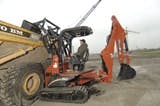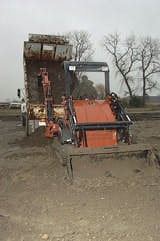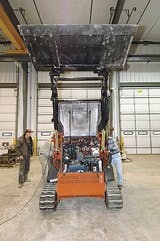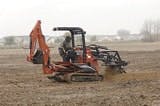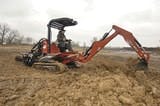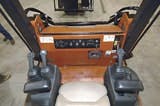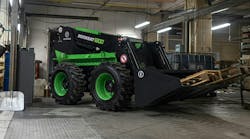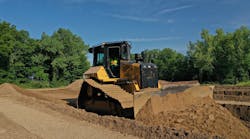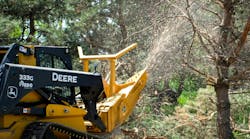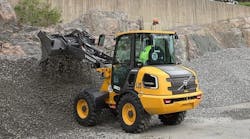Local 150 instructor/operator Scott Mennenga found the XT1600's controls straightforward and easy to use. Left-most joystick is for ground drive, with top switches for stabilizers, side switch for two-speed travel, and a front "operator's presence" switch that allows excavator repositioning. Left joystick controls swing and either dipper or boom, depending on selected pattern, and top switch is for excavator-boom offset. Right joystick controls excavator bucket and boom or dipper, and when the adjacent work-mode switch is in the loader position, also controls lift and tilt functions. Top switches are for auxiliary flow direction and electrical attachment control. Dash switches include those for auxiliary flow rate and the optional hydraulic coupler.
Being thoughtfully observant can sometimes take your thinking in a new direction. For instance, design engineers at Ditch Witch began to take note of the many equipment trailers hauling both a mini-excavator and a skid-steer (or compact track) loader — a useful combination on many job sites. This observation led to a basic question: Could the respective talents of a small excavator and those of a small attachment-handling loader be combined into one multi-purpose machine? They went to work on the idea, and what took shape was the XT850 excavator/tool-carrier, an uncommonly versatile machine that has the look of a dedicated mini-excavator from the back, and a utility loader from the front.
Now, some two years later, and motivated by the XT850's market acceptance, Ditch Witch has launched a larger version of the excavator/tool-carrier, the XT1600. The new model, says the company, is a "hybrid compact utility machine," combining the capabilities of the mini-excavator, skid-steer loader and compact backhoe-loader.
"Basically, the idea was to develop a machine that would fit a niche for the contractor who often might need two or three small machines," says Ditch Witch design engineer, Jeff Smith. "The design challenge was to build the XT1600 to function competitively with any of those dedicated machines it might replace — for instance, by giving it specs similar to those of a mini-excavator in terms of breakout forces, dig depth and reach. There are inevitably some compromises when you try to make a machine do everything, but that said, we've tried hard to minimize those areas."
During a visit to Ditch Witch last fall, we observed the XT1600 in action and thought that this new model, with its ambidextrous design, would make a fitting subject for an installment of Hands-On-Earthmoving. We subsequently asked Jeri Briegge, manager of public relations and advertising at Ditch Witch, if we could borrow a machine for evaluation, and she graciously arranged the loan through Chicago-area-based dealer, Ditch Witch Midwest.
So, on a soggy, chilly morning late last fall, Ditch Witch Midwest sales manager Dave Ban arrived with a virtually new XT1600 in tow at the Apprenticeship and Skill Improvement facility that Local 150 (International Union of Operating Engineers) maintains in Plainfield, Ill. Ban unloaded the machine in the warm, dry comfort of Local 150's big shop, where he and Local 150 instructor/operator Scott Mennenga did a walk-around tour of the machine's design and control features.
At the front of this 9,400-pound, rubber-tracked machine is a loader mechanism with a universal-type coupler that accommodates all appropriately sized skid-steer-loader attachments. (Our machine had a manual coupler, but a hydraulically actuated version is available.) To further enhance utility at the front, the XT1600 is equipped with a standard auxiliary hydraulic system, which includes a case drain and a connector for powering electrical functions on certain attachments.
At the rear is a sturdy, excavator-like digging mechanism, which provides 260 degrees of sweep and allows offset digging by pivoting both on the machine's mainframe (under the operator's station) and at the swing post. Auxiliary hydraulics and a quick-coupler also are available for the excavator end, typically for using a breaker or thumb, says Smith, but capable of handling any tool designed for a mini-excavator. According to Smith, more than a third of XT1600 units leave the factory with a rear coupler and hydraulics.
The machine's 53-hp (net) Kubota diesel engine drives dual pumps for its two-speed hydrostatic propel system, as well as dual gear pumps for the implement- and auxiliary-hydraulic circuits. Auxiliary pressure is set at 3,000 psi, and the flow rate, controlled by a switch on the dash, can be set for 15 or 26 gpm. The XT1600's undercarriage uses eight rollers per side, arranged in two bogey sets. This "equalizer track system" is designed, says Smith, to "absorb uneven terrain for a better ride and to assist with break-over when loading the machine."
Mennenga took note that the XT1600 has hydraulic and electrical test ports to facilitate checks and diagnostics, and that the machine's large tilt-up hood in the front allows easy access to routine maintenance points. He did question the accessibility of the machine's hydraulic filter, positioned low within the engine bay, but Ban removed an access panel in the operator's station and demonstrated that the filter was within easy reach through the opening.
Local 150 technician Dale Brown stopped by to look over the XT1600 and pointed out that, in his opinion, the fusible links in the machine's electrical system are a good idea. According to Ban, all of the XT1600's electronics are made by Ditch Witch's Subsite Division, which designs and produces the company's tracking equipment for its horizontal directional drills.
XT1600 performanceWe apologized to Ban for taking his spotlessly clean machine out into the rain and mud, but he said that's why high-pressure wash systems were invented. The machine clips along at 6.8 mph in high range, so Mennenga quickly reached a stockpile of wet, densely compacted soil in which to test the XT1600's ability to load and lift with the front bucket.
"The machine has plenty of power to get the bucket full. I was impressed with its aggressive push — even into this heavy, wet stuff. Lifting capacity seems exceptionally strong, and it gives no hint of wanting to tip forward when you come up with a load. When I was backing up from the pile, I did have a tendency to pull the steering joystick in the wrong direction, but a couple hours of running time would cure that. I like the steering — it's very responsive."
Although Mennenga used the XT1600 to load a small landscaper's truck that Local 150 uses for utility chores, he added a bit of perspective to the XT1600's truck-loading ability by asking one of his cohorts to bring over the Local's A25C Volvo articulated hauler. With 121 inches under the bucket hinge, the XT1600 got over the side of the Volvo just fine, but maybe could have used a couple more inches of reach to dump in the center. But that's far from a criticism; how often are you going to ask a skid-steer to load an off-highway hauler?
Mennenga then took the XT1600 to another area to dig with the excavator end. After a number of cycles, we asked for his assessment.
"The backhoe seems very strong; you can tell that it's heavy-duty and that it's exerting plenty of force. I picked a hard spot to dig, and it penetrated the ground with no problem and came up with loaded buckets without getting tippy. I did throttle back at one point to see how the backhoe would react if I had to dig around utilities, and found that it has a delicate touch to it.
"What I do think would be useful, though, is a couple of small slots in the cab floor to let you see where the outriggers are positioned. And just one mild criticism: the travel lever seems a bit close to the swing lever; you don't want to interrupt the swing motion — or break your concentration — by your hand hitting another lever."
Mennenga also proved to himself the effectiveness of the machine's offset digging capability when a load of wet muck refused to slide out of the landscaping truck. He positioned the XT1600 behind and at the center of the raised body, and without moving the machine, could swing across the entire width of the body, always keeping the bucket parallel with the sides, to pull out the soil.
Mennenga then returned to the front of the machine and switched the loader bucket for a trencher attachment. He liked the setup, because the tilt function of the coupler allowed him to position the trencher at an angle that gave the best ride. He also liked facing the trencher, and preferred that operating position, even though the XT1600's seat has stops at 45 and 90 degrees as it swings to the excavator position.
"I think a trencher on this machine is very versatile, because you can easily dig up to a corner, pull up the trencher, back around 90 degrees, and quickly resume digging. With a conventional trencher, you'd probably spend much more time repositioning. The machine maneuvers very quickly."
Final thoughtsBack in the comfort of the shop, we asked Mennenga for any final thoughts about the XT1600. He focused on the machine's overall stability and the flexibility of the excavator.
"The machine is exceptionally stable. The center of gravity seems well positioned — in the center of the machine and low to the ground. I tried to get it to tip coming out of the pile with a loaded bucket, but it held its own. I was surprised at that. The ability of the backhoe to do offset digging is a handy feature, and the switch on the joystick to pivot the boom is very convenient."
But Mennenga did have one final wish — sort of: "On a day like this, a cab would be nice. But, then again, you'd give up some of the machine's excellent visibility. I'd probably opt for visibility over comfort, especially when digging around utilities."

